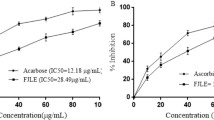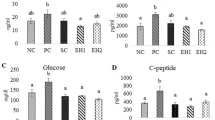Abstract
Purpose
The present study was undertaken to explore the possible anti-diabetic mechanism(s) of Emblica officinalis (EO) and its active constituent, ellagic acid (EA), in vitro and in vivo.
Method
Neonatal streptozotocin-induced non-obese type 2 diabetic rats were treated with a methanolic extract of EO (250 or 500 mg/kg) for 28 days, and blood glucose, serum insulin, and plasma antioxidant status were measured. Insulin and glucagon immunostaining and morphometry were performed in pancreatic section, and liver TBARS and GSH levels were measured. Additionally, EA was tested for glucose-stimulated insulin secretion and glucose tolerance test.
Results
Treatment with EO extract resulted in a significant decrease in the fasting blood glucose in a dose- and time-dependent manner in the diabetic rats. It significantly increased serum insulin in the diabetic rats in a dose-dependent manner. Insulin-to-glucose ratio was also increased by EO treatment. Immunostaining of pancreas showed that EO250 increased β-cell size, but EO500 increased β-cells number in diabetic rats. EO significantly increased plasma total antioxidants and liver GSH and decreased liver TBARS. EA stimulated glucose-stimulated insulin secretion from isolated islets and decreased glucose intolerance in diabetic rats.
Conclusion
Ellagic acid in EO exerts anti-diabetic activity through the action on β-cells of pancreas that stimulates insulin secretion and decreases glucose intolerance.





Similar content being viewed by others
References
Hu FB (2011) Globalization of diabetes: the role of diet, lifestyle, and genes. Diabetes Care 34(6):1249–1257. doi:10.2337/dc11-0442
Aggarwal BB, Shishodia S (2006) Molecular targets of dietary agents for prevention and therapy of cancer. Biochem Pharmacol 71:1397–1421. doi:10.1016/j.bcp.2006.02.009
Ayyanar M, Sankarasivaraman K, Ignacimuthu S (2008) Traditional herbal medicines used for the treatment of diabetes among two major tribal groups in south Tamil Nadu, India. Ethnobot Leafl 12:276–280. doi:10.1016/j.fitote.2008.06.003
Khan KH (2009) Roles of Emblica officinalis in medicine—a review. Bot Res Int 2(4):218–228
Mirunalini S, Krishnaveni M (2010) Therapeutic potential of Phyllanthus emblica (amla): the ayurvedic wonder. J Basic Clin Physiol Pharmacol 21(1):93–105. doi:10.1515/JBCPP.2010.21.1.93
D’souza JJ, D’souza PP, Fazal F, Kumar A, Bhat HP, Baliga MS (2014) Anti-diabetic effects of the Indian indigenous fruit Emblica officinalis Gaertn: active constituents and modes of action. Food Funct 5:635–644. doi:10.1039/C3FO60366K
Akhtar MS, Ramzan A, Ali A, Ahmad M (2011) Effect of Amla fruit (Emblica officinalis Gaertn.) on blood glucose and lipid profile of normal subjects and type 2 diabetic patients. Int J Food Sci Nutr 62:609–616. doi:10.3109/09637486.2011.560565
Tiwari V, Kuhad A, Chopra K (2011) Emblica officinalis corrects functional, biochemical and molecular deficits in experimental diabetic neuropathy by targeting the oxido-nitrosative stress mediated inflammatory cascade. Phytother Res 25:1527–1536. doi:10.1002/ptr.3440
Patel SS, Goyal RK, Shah RS, Tirgar PR, Jadav PD (2013) Experimental study on effect of hydroalcoholic extract of Emblica officinalis fruits on glucose homeostasis and metabolic parameters. AYU 34:440. doi:10.4103/0974-8520.127731
Ansari A, Shahriar MSZ, Hassan MM, Das SR, Rokeya B, Haque MA, Sarkar T (2014) Emblica officinalis improves glycemic status and oxidative stress in STZ induced type 2 diabetic model rats. Asian Pac J Trop Med 7:21–25. doi:10.1016/S1995-7645(13)60185-6
Pozharitskaya ON, Ivanova SA, Shikov AN, Makarov VG (2007) Separation and evaluation of free radical-scavenging activity of phenol components of Emblica officinalis extract by using an HPTLC–DPPH method. J Sep Sci 30:1250–1254. doi:10.1002/jssc.200600532
Amakura Y, Okada M, Tsuji S, Tonogai Y (2000) High-performance liquid chromatographic determination with photodiode array detection of ellagic acid in fresh and processed fruits. J Chromatogr A 896(1):87–93. doi:10.1016/S0021-9673(00)00414-3
Malini P, Kanchana G, Rajadurai M (2011) Antidiabetic efficacy of ellagic acid in streptozotocin induced diabetes mellitus in albino Wistar rats. Asian J Pharm Clin Res 4:124–128
Vattem DA, Shetty K (2005) Biological functionality of ellagic acid: a review. J Food Biochem 29(3):234–266. doi:10.1111/j.1745-4514.2005.00031.x
Farzaneh V, Carvalho IS (2015) A review of the health benefit potentials of herbal plant infusions and their mechanism of actions. Ind Crop Prod 65:247–258. doi:10.1016/j.indcrop.2014.10.057
Kahn SE (2003) The relative contributions of insulin resistance and beta-cell dysfunction to the pathophysiology of type 2 diabetes. Diabetologia 46:3–19
Gujral UP, Pradeepa R, Weber MB, Narayan KM, Mohan V (2013) Type 2 diabetes in South Asians: similarities and differences with white Caucasian and other populations. Ann N Y Acad Sci 1281(1):51–63. doi:10.1111/j.1749-6632.2012.06838.x
Ma RC, Chan JC (2013) Type 2 diabetes in East Asians: similarities and differences with populations in Europe and the United States. Ann N Y Acad Sci 1281(1):64–91. doi:10.1111/nyas.12098
Asian Association for the Study of Diabetes (2013) Promoting research for better diabetes care in Asia: Kyoto declaration on diabetes. J Diabetes Investig 4:222–224. doi:10.1111/jdi.12073
Tuomi T, Santoro N, Caprio S, Cai M, Weng J, Groop L (2014) The many faces of diabetes: a disease with increasing heterogeneity. Lancet 383:1084–1094
Portha B, Blondel O, Serradas P et al (1989) The rat models of non-insulin dependent diabetes induced by neonatal streptozotocin. Diabete Metab 15:61–75
Arulmozhi DK, Veeranjaneyulu A, Bodhankar SL (2004) Neonatal streptozotocin-induced rat model of type 2 diabetes mellitus: A glance. Indian J Pharmacol 36:217–221
Portha B, Movassat J, Cuzin-Tourrel C et al (2007) Neonatally streptozotocin-induced (n-STZ) diabetic rats: a family of type 2 diabetes models. In: Shafrir E (ed) Animal models of diabetes, 2nd edn. CRC Press, Boca Raton, pp 223–250
Hafizur RM, Kabir N, Chishti S (2011) Modulation of pancreatic β-cells in neonatally streptozotocin-induced type 2 diabetic rats by the ethanolic extract of Momordica charantia fruit pulp. Nat Prod Res 25:353–367. doi:10.1080/14786411003766904
Hafizur RM, Kabir N, Chishti S (2012) Asparagus officinalis extract controls blood glucose by improving insulin secretion and β-cell function in streptozotocin-induced type 2 diabetic rats. Br J Nutr 108:1586–1595. doi:10.1017/S0007114511007148
Noyan T, Balaharoğlu R, Kömüroğlu U (2005) The oxidant and antioxidant effects of 25-hydroxyvitamin D3 in liver, kidney and heart tissues of diabetic rats. Clin Exp Med 5:31–36
Ohkawa H, Ohishi N, Yagi K (1979) Assay for lipid peroxides in animal tissues by thiobarbituric acid reaction. Anal Biochem 95:351–358
Chandra D, Ramana KV, Wang L, Christensen BN, Bhatnagar A, Srivastava SK (2002) Inhibition of fiber cell globulization and hyperglycemia-induced lens opacification by aminopeptidase inhibitor bestatin. Invest Ophthalmol Vis Sci 43:2285–2292
Siddiqui BS, Hasan M, Mairaj F, Mehmood I, Hafizur RM, Hameed A, Khan Shinwari Z (2014) Two new compounds from the aerial parts of Bergenia himalaica Boriss and their anti-hyperglycemic effect in streptozotocin-nicotinamide induced diabetic rats. J Ethnopharmacol 152(3):561–567. doi:10.1016/j.jep.2014.02.002
Hafizur RM, Hameed A, Shukrana M, Raza SA, Chishti S, Kabir N, Siddiqui RA (2015) Cinnamic acid exerts anti-diabetic activity by improving glucose tolerance in vivo and by stimulating insulin secretion in vitro. Phytomedicine 22(2):297–300. doi:10.1016/j.phymed.2015.01.003
Hanson RL, Pratley RE, Bogardus C, Narayan KV, Roumain JM, Imperatore G, Knowler WC (2000) Evaluation of simple indices of insulin sensitivity and insulin secretion for use in epidemioiogic studies. Am J Epidemiol 151:190–198
Fujita K, Nishizawa H, Funahashi T, Shimomura I, Shimabukuro M (2006) Systemic oxidative stress is associated with visceral fat accumulation and the metabolic syndrome. Circ J 70:1437–1442. doi:10.1253/circj.70.1437
Vincent HK, Taylor AG (2005) Biomarkers and potential mechanisms of obesity-induced oxidant stress in humans. Int J Obes (Lond) 30:400–418. doi:10.1038/sj.ijo.0803177
Luo W, Zhao M, Yang B, Shen G, Rao G (2009) Identification of bioactive compounds in Phyllanthus emblica L. fruit and their free radical scavenging activities. Food Chem 114(2):499–504. doi:10.1016/j.foodchem.2008.09.077
Hincapié CA, Monsalve Z, Seigler DS, Alarcón J, Cespedes CL (2011) Antioxidant activity of Blechnum chilense (Kaulf.) Mett., Curcuma domestica Valeton and Tagetes verticillata Lag. & Rodriguez. Boletín latinoamericano y del Caribe de plantas medicinales y aromáticas 10:315–324
Saeed MK, Deng Y, Dai R, Li W, Yu Y, Iqbal Z (2010) Appraisal of antinociceptive and anti-inflammatory potential of extract and fractions from the leaves of Torreya grandis Fort Ex. Lindl. J Ethnopharmacol 127:414–418
Prasad KN, Hao J, Yi C, Zhang D, Qiu S, Jiang Y et al (2009) Antioxidant and anticancer activities of wampee [Clausena lansium (Lour.) Skeels] peel. BioMed Res Int 2009. doi:10.1155/2009/612805
Roome T, Dar A, Ali S, Naqvi S, Choudhary MI (2008) A study on antioxidant, free radical scavenging, anti-inflammatory and hepatoprotective actions of Aegiceras corniculatum (stem) extracts. J Ethnopharmacol 118:514–521
Acknowledgments
This work was supported by a HEC Grant (No. 20-1963/R&D/10/9164) to Md. Hafizur Rahman from the Higher Education Commission (HEC), Pakistan. We are thankful to the Asian Network of Research on Antidiabetic Plants (ANRAP) for financial support to Abdul Hameed for a visit to BIRDEM, Dhaka, Bangladesh. We highly acknowledge Sidra Chisti for skillful technical assistance in animal handling, feeding extract and blood glucose estimation. We would like to show our gratitude to Prof. Dr. Rafat Ali Siddiqui (Department of Medicine, Indiana University School of Medicine, Indianapolis, Indiana, USA) and Dr. Shahidul Islam (Department of Molecular, Cellular and Developmental Biology, Yale University, USA) for critical reading of the manuscript and their comments.
Authors’ contributions
R M. H. and N. F. designed the research. R. M. H. and N. F. conducted the research, analyzed the data and also wrote the manuscript. R. M. H. analyzed the immunohistochemical data. S. A., M. N., and N. F. were involved in HPLC analysis. A. H. was involved in islet isolation and insulin secretion assay. N. K. was involved in technical support for microscopic analysis and morphometry and writing of the manuscript.
Author information
Authors and Affiliations
Corresponding author
Ethics declarations
Conflict of interest
We declare that we have no conflict of interest.
Rights and permissions
About this article
Cite this article
Fatima, N., Hafizur, R.M., Hameed, A. et al. Ellagic acid in Emblica officinalis exerts anti-diabetic activity through the action on β-cells of pancreas. Eur J Nutr 56, 591–601 (2017). https://doi.org/10.1007/s00394-015-1103-y
Received:
Accepted:
Published:
Issue Date:
DOI: https://doi.org/10.1007/s00394-015-1103-y




